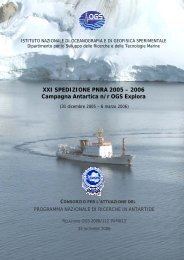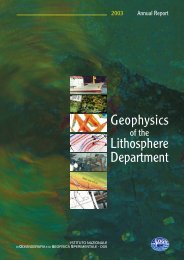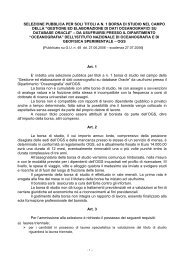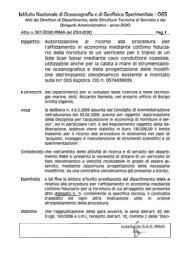Geophysical data acquisition - OGS
Geophysical data acquisition - OGS
Geophysical data acquisition - OGS
Create successful ePaper yourself
Turn your PDF publications into a flip-book with our unique Google optimized e-Paper software.
Ground penetrating radar for environmental problems<br />
J.M. CARCIONE<br />
F. CAVALLINI<br />
G. PADOAN<br />
G. SERIANI<br />
The ground-penetrating radar (GPR) has unique capabilities as a subsurface<br />
exploration device; as such, its applications (since 1992) include archaeology,<br />
mining, glaciology, hydrogeology, and environmental remediation. But its<br />
performance is highly sensitive on the knowledge of the physics of the medium and<br />
of the instrument itself. Therefore, basic research in this field is of crucial<br />
importance for pracical applications as well. Many concepts and techniques that<br />
were devised for seismic waves can be applied to the processing of GPR <strong>data</strong>, in<br />
virtue of the mathematical analogy between electromagnetic and elastodynamic<br />
equations. This research, funded by the Regional Government of Friuli - Venezia<br />
Giulia (northeastern Italy), aims at exploiting these methods for the monitoring of<br />
a polluted area.<br />
The exploding-reflector method, originally developed for seismic waves, has been<br />
adapted to produce zero-offset synthetic radargrams without need to compute<br />
common-shot records. The basic underlying idea consists in assuming that each<br />
reflecting point acts at the initial time as an instantaneous source of motion with<br />
a magnitude proportional to the normal-incidence reflection coefficient. The<br />
magnetic permeability is used as a free parameter to obtain a constant-impedance<br />
model and, so, to avoid multiple reflections. Moreover, the condition that the phase<br />
velocity remain unchanged also requires the scaling of the permittivity and of the<br />
conductivity. Thus, the method generates normal-incidence reflections, i.e., those<br />
having identical downgoing and upgoing wave paths. In an example with<br />
transverse-magnetic equations, this method has shown more accuracy, but less<br />
efficiency, than the plane-wave technique.<br />
Analytical solution for lossy anisotropic media has been developed. Microstructural<br />
features, fine layering, and fluid-filled cracks give rise to electric and magnetic<br />
anisotropy, while mineralized water in the fractures makes conductivity<br />
anisotropic. Water relaxation and ferromagnetism are responsible of energy<br />
dissipation. This motivates an orthotropic constitutive law in which attenuation<br />
stems from the Debye model. The corresponding solution is obtained in the<br />
frequency domain from a change of coordinates that turns Maxwell’s equations<br />
into Helmholtz equations, which are solved analytically. Then, the solution in time<br />
domain is recovered by numerically computing the inverse Fourier transform. The<br />
results are in agreement with a plane-wave analysis of the slowness, the<br />
attenuation and the energy velocity.<br />
Simulation of the ground motion caused by earthquakes<br />
and site response analysis<br />
E. PRIOLO<br />
G. LAURENZANO<br />
Synthetic seismograms computed as a solution of the full-wave propagation<br />
through a realistic geological structure can reproduce accurately much of the<br />
effects of medium heterogeneity and local soil conditions on the ground motion<br />
caused by earthquakes. They are a powerful tool for building seismic hazard<br />
scenarios as well as for performing site response analyses. For this kind of studies,<br />
we currently use two methods, i.e. the 2-D Chebyshev spectral element method<br />
28






